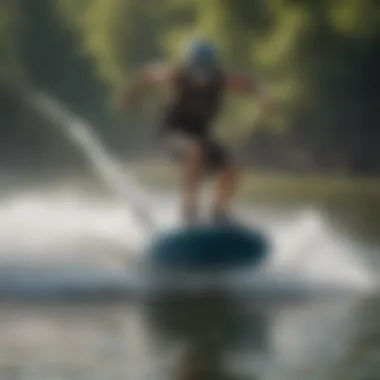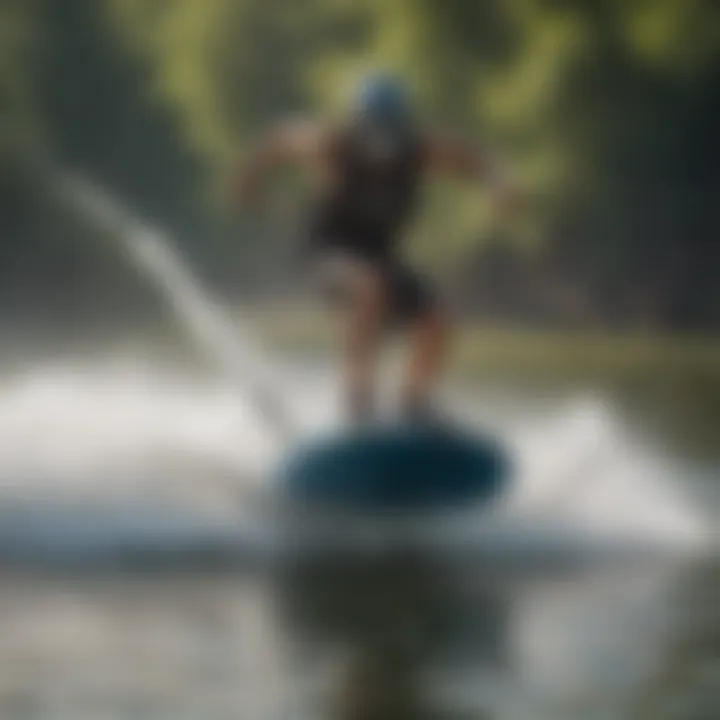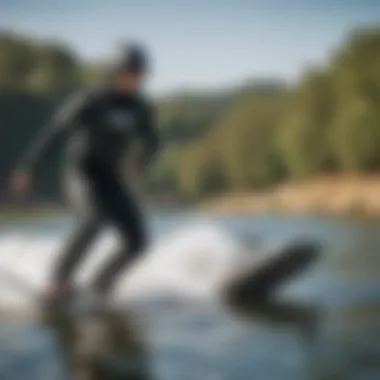A Guide to the Smallest Wakeboards on the Market


Intro
In the ever-evolving world of watersports, the size of your equipment can make all the difference. With wakeboarding becoming increasingly popular, enthusiasts are now looking into lighter, smaller boards. This article will deep dive into the ins and outs of the smallest wakeboards available on the market, shedding light on their unique designs and performance attributes.
Whether you're a seasoned rider or a newcomer still finding your feet, understanding the nuances of smaller wakeboards can be a game-changer. We’ll explore how size impacts not only your performance but also your overall experience on the water. The balance between maneuverability and stability becomes critical, especially when considering your skill level and the conditions you choose to ride in.
By the end of this guide, you should feel confident in selecting the right small wakeboard that fits your capabilities and aspirations. We'll also provide practical tips aimed at enhancing your time on the water, ensuring you get the most out of your equipment.
Gear Essentials
Finding the right gear is crucial for success, especially when considering smaller wakeboards. The size and shape can vary significantly, influencing agility, stability, and overall performance. Here's a closer look at what you need to know.
Top Picks for Watersports Equipment
When searching for small wakeboards, a few standout options catch the eye:
- Liquid Force Rocket: A nimble board designed for quick turns and tight spins. Ideal for those who want a more playful ride.
- Hyperlite Jinx: This board offers wonderful balance and is perfect for beginners transitioning into tricks. Its lightweight design eases maneuverability.
- Ronix District: Well-engineered, this board is effective for both maneuvers and stability on the water. Suitable for intermediate riders looking to step up their game.
Each of these boards brings its own flavor to the ride, whether it’s high-speed action or a focus on tricks and jumps. But keep in mind that personal preference plays a huge role for every individual.
Maintenance and Care Tips for Gear
Taking care of your equipment ensures longevity and consistent performance. Simple practices like washing off salt and sand after each session can make a significant difference. Also, store your boards in a cool, dry place to prevent warping.
"Regular maintenance can extend the life of your gear and enhance your overall experience on the water."
Remember to inspect for nicks and scratches that could affect performance. A little attention now can save headaches later on.
Techniques and Tips
Choosing the right board is only the beginning. To truly maximize performance, some techniques and tips will serve you well.
Beginner Tips for Each Watersport
If you are just starting, learn to find your center of gravity early on. This will help you maintain balance, especially on smaller boards. Not to mention, practice edging by shifting your weight, as small adjustments can lead to smoother rides.
Advanced Techniques for Skill Enhancement
For more seasoned riders, try incorporating spins and flips into your routine. Start with basic tricks and gradually add complexity. Using your weight effectively will help control the board, especially in tricky situations.
Additionally, understanding how the wind and water patterns affect your ride can be a competitive edge. Always be aware of your surroundings to maneuver effortlessly.
Through this comprehensive guide, our intention is to empower you with the right knowledge, gear essentials, and practical tips tailored to your needs. As you grow in this sport, having the right information can ensure a fulfilling and thrilling experience on the water.
Prelims to Wakeboarding
Wakeboarding isn't just a sport; it's a thrilling aquatic experience that marries artistry with athleticism. For enthusiasts diving into this energetic pastime, understanding its foundations can make all the difference. This section sets the stage for exploring the specifics of wakeboarding, focusing particularly on the equipment that fuels excitement - namely the wakeboard.
To kick things off, let's consider the essence of the sport. At its core, wakeboarding involves riding a board while being towed behind a boat. The adrenaline-pumping act isn’t merely about standing on a board; it’s about how well one can glide over the water, perform tricks, and navigate the waves. Each of these aspects hinges significantly on the choice of wakeboard, especially when exploring the smallest variants available.
When it comes to selecting a wakeboard, factors like size, design, and material all come into play. A small wakeboard, for example, offers unique characteristics that cater to specific riding styles or skill levels. This can be especially beneficial for riders looking to enhance their agility and trick performance.
"Understanding wakeboarding is understanding yourself on the water."
Let’s consider who benefits from a smaller wakeboard. The riders aiming for max agility often find smaller boards advantageous. Not only do they allow for quick turns, but they also facilitate the execution of tricks with greater ease. This size also challenges the rider to develop better balance and coordination, which are invaluable skills in the long run.
Moreover, the nuances of ride performance can’t be overstated. The balance, control, and speed one experiences on a smaller board can contribute to a more exhilarating ride. These boards demand attention to detail, encouraging a deeper connection between the athlete and the water. Thus, embarking on this journey means embracing the learning curve that comes with smaller boards.
In simpler terms, getting a good grip on wakeboarding ensures that riders harness their full potential. As we delve deeper into this guide, we'll reveal how the size of the board influences not just individual performance but also how various boards stack against one another in the world of watersports. Whether you’re just starting out or looking to refine your skills, understanding the mechanics behind choosing the right board will open doors to a richer wakeboarding experience.
Understanding the Importance of Board Size
When we talk about wakeboarding, the size of the board is like the backbone of the entire experience. Selecting the right board size can make or break your time on the water. It isn’t just about what looks good or what feels trendy. In fact, it’s rooted in how the size directly affects performance, comfort, and safety.
A smaller wakeboard specifically caters to a different set of skills and abilities. Those who are more experienced often find smaller boards provide advantages in agility and maneuverability. However, this doesn’t mean that everyone should rush to get one. Understanding the relationship between board size and performance is essential whether you’re a beginner or have been riding for years.
Board Dimensions and Performance
The dimensions of a wakeboard—its length, width, and thickness—play a pivotal role in determining how it performs. A board that’s too big can feel unwieldy and might require extra effort to control. Conversely, a smaller board encourages a responsive experience. Think about it like this: tighter turns and quicker spins become second nature on a smaller board.
- Length: Shorter boards tend to be lighter, which usually enhances tricks and stunts. But remember, if the board is too short, it may not provide the necessary buoyancy, making initial take-offs more difficult.
- Width: A wider board generally offers more surface area that helps with stability. Thus, it’s crucial to balance between width and height, especially for those who are just finding their footing.
- Thickness: Thicker boards can absorb shocks better, which is particularly beneficial when you land jumps. Smaller boards typically sacrifice some thickness for agility.
So, selecting the right dimensions is about knowing your individual skills. The board that works best will offer a balance between your experience level and the type of riding you wish to pursue.
Impact on Maneuverability
Maneuverability is essentially how easily you can control the wakeboard, and board size is a game changer here. Smaller wakeboards allow for a heightened sense of freedom and creativity. You’ll find yourself taking sharper turns and trying out new tricks without feeling bogged down.
- Easier Tricks: Smaller boards can make executing spins and flips much easier. For riders aiming to impress while staying nimble, these boards are key. One look at pros during competitions shows how they fly through the air with style, all thanks to their gear.
- Wind Resistance: Less volume means less resistance against wind. This is a valuable trait, especially if you’re in areas with choppy waters or strong gusts.
- Upholstery and Floatation: Smaller boards don’t float as well compared to their larger counterparts. This can affect how a rider initiates starts or grabs the wake for tricks. Balancing between size and floatation becomes a meticulous task.
In essence, while smaller wakeboards may seem appealing for their maneuverability, they also demand a higher skill level. Newcomers might feel overwhelmed without the stability of a larger board. Ultimately, the goal is to harmonize size with the rider’s unique style and expertise.
The Smallest Wakeboards Available
In the vibrant world of wakeboarding, the smallest wakeboards hold a unique place, often overlooked by many but esteemed by those who appreciate precision and agility on the water. These compact boards are not just toys; they represent a blend of engineering and design, tailored for those who wish to elevate their wakeboarding experience to new heights. With various manufacturers pushing the envelope in terms of innovation, it becomes imperative to examine what these smaller boards can offer and how they stand against their larger counterparts. Whether it’s about mastering tricks or navigating through choppy waters, understanding the nuances of the smallest wakeboards can be vital for enhancing performance.
Manufacturer Comparisons


When it comes to the smallest wakeboards, one must sift through a spectrum of manufacturers. Companies like Hyperlite, Liquid Force, and Ronix have carved out niches that cater to diverse preferences among riders.
- Hyperlite boasts several models, such as the Hyperlite Jinx, that combine lightweight materials with versatile shapes. They're known for their responsiveness and ease of use, especially for those keen on tricks.
- Liquid Force, on the other hand, tends to emphasize a fusion of performance and aesthetic design. Their boards, like the Liquid Force Butterstick, are crafted for a smooth ride while also being visually striking.
- Ronix presents a curated selection, emphasizing how the board’s build can make all the difference. The Ronix One Timebomb is popular for its durable structure and the unique flex patterns that adapt to a rider’s weight and skill level.
Each of these manufacturers prioritizes rider feedback, leading to continuous improvements. Thus, understanding the specific features of their small boards could help you find the right fit for your needs.
Unique Design Features
Small wakeboards are laden with unique design features that differentiate them from standard models. Here are some elements crucial to their performance:
- Reduced Surface Area: Smaller boards allow for quicker edge-to-edge transitions. This reduces the drag when carving, which means more speed when cutting through the wake.
- Narrow Profile: This aspect helps in executing spins and slides with ease, making them ideal for advanced riders aiming to master complex tricks.
- Tailored Flex Patterns: Many models incorporate varying flex characteristics, which aid in absorbing impact during landings and enhance pop off the wake.
- Lightweight Materials: Advances in technology have introduced new materials like carbon fiber or lightweight foam cores, giving riders a responsive feel without the heft.
Contemplating these unique features is essential when choosing a wakeboard. It’s a marriage of style, flexibility, and performance that can significantly influence the rider's quality of experience on the water.
"Selecting the right equipment is not purely about size; it’s about how well the board complements your style and skill level."
As you explore the world of small wakeboards, keep an eye on how these features resonate with your riding approach.
Advantages of Using a Smaller Wakeboard
When it comes to wakeboarding, size really does matter. Small wakeboards, despite their diminutive nature, offer a plethora of benefits that can elevate a rider's experience on the water. Understanding these advantages can help decide if a smaller board is the right fit for your needs. Let's dive into the two significant benefits associated with smaller wakeboards: increased agility and enhanced trick capability.
Increased Agility on the Water
One of the primary draws of a small wakeboard is the agility it provides. Smaller boards are typically lighter and easier to maneuver. This is particularly noticeable during sharp turns and rapid transitions. For instance, when someone decides to carve sharply in one direction, a smaller board responds more quickly, allowing the rider to change their direction with finesse.
With experience, many riders also claim that smaller boards make it easier to avoid obstacles in the water. This added nimbleness reduces the chance of collisions, a critical aspect for both safety and enjoyment. In essence, if you’re looking to enhance your movements on the wake, a smaller wakeboard might just be the way to go.
"A smaller wakeboard takes your riding style up a notch, giving you the freedom to maneuver as you please."
Additionally, these boards often have a tighter turning radius. What this means for you is that when you take to the water, the sweet spots are just a little more reachable. It feels less like a massive ship turning and more like a sleek dolphin gliding through waves. This agility can be crucial whether you are just starting out or working on advanced techniques.
Enhanced Trick Capability
Riders yearning to perform tricks will find smaller wakeboards particularly advantageous. Smaller boards inherently have less surface area, making them lighter and easier to pop off the wake. This buoyancy is vital for executing aerial maneuvers. Tricks such as spins and flips become more attainable as you gain a better sense of control with these boards.
Moreover, smaller wakeboards can create a quicker response time. Riders report that a smaller board feels more like an extension of their body. The ability to quickly adjust midair can be the difference between nailing that flip or landing flat.
Here are some specific advantages of enhanced trick capability with a smaller wakeboard:
- Higher Pop: The lighter build offers a bigger lift off the wave.
- Better Balance: Enabling finer adjustments while airborne.
- Improved Consistency: As you master new tricks, they feel more repeatable.
In summary, while smaller wakeboards present challenges, they also unlock a realm of possibilities in terms of agility and tricks. As you exploit the nuances of your board, your confidence and performance are bound to grow.
Challenges of Smaller Wakeboards
Choosing a smaller wakeboard can result in some rewarding experiences on the water, but it’s not all smooth sailing. These boards, while facilitating agility and trick execution, come with their fair share of challenges. Understanding these challenges is key for any rider looking to maximize their performance and enjoyment. Whether you are a newbie stepping into the world of wakeboarding or an experienced enthusiast, awareness of these considerations can make a significant difference in your overall ride.
Stability and Control Concerns
A smaller wakeboard can often feel like riding a horse that’s a bit too spirited for its own good. The smaller the board, the more responsive it tends to be, yet this can also mean decreased stability. When you engage with a smaller board, you may notice that subtle shifts in your body position translate directly into swift changes in direction. This quality can be thrilling, especially if you're aiming to pull off tricks. However, it can also lead to a sense of instability for some riders, particularly those who are still developing their balance.
Riders accustomed to larger boards often find themselves navigating an uncharted territory with a smaller size. It becomes essential to understand that the margin for error shrinks significantly. This leads to a couple of aspects worth mentioning:
- Foot Placement: With less surface area, the positioning of your feet becomes critical. Misalignment can result in a lack of control and even wipeouts.
- Choppy Water: The board's reduced length might struggle to maintain a steady glide in choppy waters, making it easier to lose balance.
Over time, riders can develop the ability to harness a smaller board's maneuverability while mitigating these stability concerns through practice and an understanding of body dynamics. However, this doesn’t erase the reality that initial attempts might find you swimming more than gliding.
Increased Risk of Beginner Errors
From a beginner's standpoint, smaller wakeboards may present a daunting challenge. First-time riders often encounter an enthusiastic sense of adventure, but that can quickly turn into frustration if the board doesn’t behave as expected. The faster reaction time and enhanced responsiveness of smaller boards can amplify common mistakes.
For those just starting, certain errors tend to come up more frequently:
- Bad Posture: Slouching or uneven weight distribution can lead to abrupt falls forward or backward, as a smaller board reacts to these shifts more dramatically.
- Overcompensating: Riders might feel inclined to make exaggerated movements to maintain balance, which can quickly plunge them into a cycle of inconsistency and anxiety.
- Speed Control Misjudgment: The thrill of zipping across the water can tempt beginners to overlook control at speed, leading to overshooting jumps or veering off course rapidly.
Learning on a smaller wakeboard may feel like a double-edged sword; on one side, there’s the potential for swift improvement in skills and technique, while on the other, there lurks the risk of developing bad habits that may prove hard to unlearn.
It's advisable for beginners to practice on a larger board initially. This helps build foundational skills before transitioning to that smaller wakeboard which promises the exhilarating rides and tricks.
In summary, while smaller wakeboards can elevate your wakeboarding experience with agility and trick potential, confronting the stability issues and the risks of beginner mistakes is paramount. The right knowledge and practice will turn these challenges into stepping stones toward becoming a proficient rider.
Selecting the Right Small Wakeboard
Choosing the right small wakeboard is paramount for maximizing enjoyment and performance on the water. This decision goes beyond mere preference; it influences not just how well one can ride but also safety and ability to progress in the sport. With numerous options in the marketplace, knowing the elements that play into the selection becomes crucial. Factors such as skill level, weight, and individual size characteristics can heavily impact riding experience. For example, a board that seems fitting for one rider might be totally off-kilter for another, making understanding these distinctions vital.
Evaluating Skill Levels
When selecting a wakeboard, the rider's skill level should take the front seat. A beginner rider might be tempted to jump on a smaller board while chasing the allure of agility and trick potential. However, this can lead to a steep learning curve, often resulting in discouragement.
For beginners, a slightly larger board can provide a more stable platform, helping to build confidence while learning basic techniques. As skills progress, transitioning to a smaller board can make sense, as it allows for more advanced maneuvers. On the flip side, experienced riders may find a smaller wakeboard enhances their tricks and turns by allowing quicker edge transitions and a more responsive feel. Thus, matching the board to one’s ability level is key; avoid jumping in over your head.
Assessing Weight and Size Parameters
The weight and size of a rider are critical parameters when choosing a small wakeboard. The right size ensures not only solidity during maneuvers but also affects buoyancy and control. If a rider is too heavy for a small board, it can sink deeper in the water, making it difficult to generate speed or perform well on the wake. Conversely, too light a rider on a board that's too large may find themselves struggling to keep the board up on the water surface.
To find the appropriate board size, most manufacturers provide a weight range for their products. It's advisable to consult these specifications and even seek advice from knowledgeable shop staff or experienced riders. Moreover, considering foot size also plays a role; if your feet are crammed into the wakeboard bindings, it can impact comfort and performance.
Choosing wisely in these areas contributes to a smoother experience on the water and is fundamental to enjoying this exhilarating sport. Once the right board is selected, it opens the door to many water adventures, pushing the limits of creativity and fun.


Maintenance and Care for Wakeboards
Owning a wakeboard, particularly one on the smaller side, comes with a certain level of responsibility. It's not merely about the thrill and excitement of gliding over the water; all that adrenaline needs a sturdy board underneath to keep things safe and enjoyable. The importance of maintaining your wakeboard cannot be overstated. Regular care not only ensures the longevity of the board, but it can also drastically enhance your performance on the water.
Proper maintenance can save you from unnecessary repairs and replacements, not to mention the frustration of struggling with a board that's seen better days. Over time, wear and tear can accumulate – scratches, dings, and even delamination. Keeping an eye on these issues and addressing them early can greatly improve your experience. Just like regular dentist check-ups, a little upkeep goes a long way in prevention!
Cleaning Procedures
The first step in maintaining your wakeboard is knowing how to clean it effectively. After a day of riding, your board is likely to collect dirt, algae, and other debris, especially if you've been wakeboarding in freshwater. Here’s a simple yet effective cleaning procedure you can follow:
- Rinse with clean water: Start by rinsing your board with fresh water, preferably at the lake or by the shore. This helps to remove any surface dirt, sand, or other gunk.
- Use a mild soap: After rinsing, a gentle soap solution can be used to wipe down the board. Avoid anything abrasive, as that can scratch the surface. A sponge or soft cloth works wonders here.
- Dry it well: Once cleaned, make sure you dry your board thoroughly. A damp board left improperly stored can develop mildew or even corrosion on metal parts.
It’s essential to stay consistent with your cleaning routine. Think of it as an investment in the performance of your wakeboard; better care leads to better rides.
Storage Recommendations
Storing your wakeboard correctly is just as important as keeping it clean. Improper storage can lead to unnecessary damage, and nobody wants to pull out a warped board at the start of summer! Here are some straightforward tips for effective storage:
- Keep it out of the sun: Excessive exposure to sunlight can cause fading and weaken the materials. It’s a good idea to store your board in a cool, shaded location or in a bag designed for wakeboards.
- Hanging vs. laying down: If possible, hang your wakeboard. This helps avoid pressure points that can cause bending or cracking over time. If hanging isn’t an option, lay it flat in a position where it won’t be constantly moved around.
- Avoid damp areas: Storing the board in soggy or humid locations can foster mold or long-term damage to the board’s internal structure.
In essence, proper care and maintenance of your wakeboard can dramatically enhance your overall experience on the water. As the saying goes, "An ounce of prevention is worth a pound of cure." Keep that board in prime condition, and you’ll be carving up those waves like a pro for years to come.
Technique for Riding Smaller Wakeboards
When it comes to the world of wakeboarding, mastering the technique for riding smaller wakeboards can make all the difference between cutting through the water like a hot knife through butter and feeling like you’re stuck in molasses. Smaller boards provide unique advantages, such as enhanced agility and the ability to execute tricks with greater finesse. However, they also come with their own set of challenges. Understanding and implementing the right techniques will not only improve your performance but also boost your confidence when you hit the water.
Body Positioning and Balance
To ride a smaller wakeboard effectively, you have to mind your body positioning and balance. It's not just about standing there; it’s about how you distribute your weight and keep your posture aligned. Here’s why this is crucial:
- Gravity and Center of Mass: Smaller boards tend to have less surface area, meaning they are more sensitive to shifts in your center of mass. Keep your knees slightly bent and lower your center of gravity to maintain stability. Too upright, and you risk tipping over.
- Weight Distribution: Leaning forward can help when gaining speed, but if too far forward, you might nosedive into the water. Try to keep your weight centered over the board, adjusting as needed based on the conditions of the water.
- Core Engagement: Engage your core to maintain balance. A strong core helps to keep your legs steady and allows you to respond quickly to any shifts in balance, especially when you're tackling larger wakes or making sharp turns.
By practicing these elements, you create a solid foundation that allows you to explore the capabilities of your small wakeboard, making it feel less intimidating and more manageable.
Executing Tricks Effectively
With a firm understanding of body positioning, you can move on to executing tricks effectively on a smaller wakeboard. The agile nature of these boards presents both the opportunity and the challenge of performing advanced maneuvers. Here’s how to get the most out of your tricks:
- Start with Basics: Before attempting complex tricks, ensure your basic skills are solid. Simple jumps and 180s can build your confidence and form a bridge to more advanced moves.
- Commitment and Timing: Tricks require a level of commitment that can't be understated. Timing your jumps with the wake is vital; pop off the wake at just the right moment to gain the altitude needed for spins or flips.
- Practice Rotation and Landing: When performing rotations, think about your head and shoulders leading the movement. They dictate the rotation of your body. Upon landing, aim to absorb the impact with bent knees. This not only helps maintain balance but also protects your joints.
- Learn from Others: Watching videos or, even better, riding with experienced wakeboarders can provide valuable insights. Consider joining local wakeboarding groups or forums, like on reddit.com, to share experiences and tips.
Incorporating these techniques will not only elevate your wakeboarding game but also enhance your enjoyment on the water. Remember, riding smaller boards might take a bit more finesse, but once you get the hang of it, the rewards are substantial.
Safety Considerations
When it comes to wakeboarding, safety shouldn't be an afterthought. This sport, like many others, comes with inherent risks, especially when you’re using smaller boards that can affect your balance and control. Understanding safety measures is not just about avoiding accidents; it's ensuring a fulfilling experience on the water.
Understanding the Risks
Smaller wakeboards, while offering a unique advantage in agility and trick performance, can pose specific risks that riders must be aware of. The compact size may limit stability, meaning that a single miscalculation can lead to falls or spills. It's vital for riders, irrespective of skill level, to be vigilant and recognize the potential dangers.
Common risks include:
- Loss of Balance: With less surface area to work with, falls can happen quicker than on standard boards.
- Injury from Collisions: As riders push for tricks and jumps, the chance of colliding with obstacles or even other riders increases.
- Suboptimal Conditions: Smaller boards can be more challenging to control in choppy waters, making it tougher to stay balanced.
"Being aware of your surroundings and knowing your own limits can prevent many common wakesurfing injuries."
This highlights that knowledge paired with caution is one's best ally while engaging in wakeboarding. Always be prepared for the possibility of getting a bit wet, but keep a clear head to avoid more serious mishaps.
Protective Gear Recommendations
Equipping oneself with protective gear is non-negotiable, especially when using smaller wakeboards. The right gear can significantly reduce the risk of injuries and enhance your riding confidence.
Here’s a rundown of essential gear:
- Helmets: A good-quality helmet can be a lifesaver. It's crucial for protecting against head injuries during falls.
- Impact Vests: These vests not only provide flotation but also cushion impacts, making them a great choice for beginners and experienced riders alike.
- Wetsuits: While primarily for warmth, wetsuits can also provide some protection against abrasions if you fall.
- Bindings: Ensure that the board’s bindings fit snugly, providing support and reducing the chance of ankle injuries.
Choosing the right gear is not just about style; it's a matter of safety and necessity, especially when tackling the challenges presented by small wakeboards.
Ultimately, prioritizing safety ensures not only a more enjoyable experience on the water but also the opportunity for growth and progression in wakeboarding.
Expert Insights and Testimonials
Understanding the nuances of wakeboarding often requires the input of seasoned practitioners. Expert insights and testimonials play a crucial role in painting a well-rounded picture of the smallest wakeboards available. By drawing on real-world experience, these insights provide clarity on how various boards perform in different conditions, shedding light on specific factors such as design, weight distribution, and the psychology of riding smaller boards.
Interviews with Professionals
Engaging with professionals in the wakeboarding realm provides valuable perspectives that can’t be found in manuals or marketing brochures. These individuals, often with years of experience under their belt, can offer telling anecdotes about what makes a small wakeboard truly stand out. For instance, when interviewing a pro like Amber Wing, one might discover how the lighter weight of a smaller board allows for quicker spins and trick executions that can leave spectators awestruck. Conversations like these are essential as they highlight practical applications of board size and construction that prospective buyers might not consider. Pro-focused interviews can answer questions such as:
- How do smaller boards compare when riding in choppy waters?
- What changes should beginners expect when switching from a larger board?
Furthermore, these experts often discuss their personal favorites within smaller boards. The personal touch adds authenticity, creating a narrative that resonates with both novices and experienced riders alike.
User Experiences and Reviews
Beyond the professionals, everyday users share their stories that contribute significantly to a better understanding of small wakeboards. They often discuss the gritty details of transitions, stability adjustments, and the learning curves faced during their journeys. These testimonials can be found in forums and social media platforms, where a community thrives on shared experiences. For instance, a user review on Reddit shared how a specific small board allowed them to progress from basic tricks to flips within one season.
Some takeaway elements from these reviews include:
- Easy maneuverability: Users often echo similar sentiments regarding the agile nature of smaller boards, emphasizing their ability to whip through turns effortlessly.
- Learning curve: While many mention a steeper learning curve, they also discuss the immense satisfaction felt when mastering their smaller board's capabilities.
- Specific brands: Identifying brands and models that users loved or disliked helps future buyers to navigate the flooded market of wakesurf equipment.


In summary, expert insights and user testimonials create a rich tapestry of information beneficial to anyone looking to dive deeper into the world of small wakeboards. They not only lend credibility but also connect potential buyers with a community of enthusiasts, ultimately enriching the overall riding experience for all.
The Future of Small Wakeboards
As wakeboarding continues to gain traction among enthusiasts, the spotlight is increasingly turning to the dynamics of smaller wakeboards. The future of small wakeboards is vital not just for performance but also for the innovation of skiers and boarders. When users grasp the shifting landscape of board size, new features, and overall technological enhancements, they can better align their choice of gear with personal style and skill level.
Advancements in Technology
In the realm of wakeboarding, technology is akin to fine-tuning an engine. Makers are constantly experimenting with new materials and manufacturing techniques that reshape how boards are structured. For instance, many manufacturers are now employing advanced composite materials, which allows for a remarkable strength-to-weight ratio. This means smaller boards can offer superior performance while maintaining a lower weight, making them easier to maneuver without compromising durability.
Another significant shift can be seen in the incorporation of smart technologies. Some brands are exploring boards embedded with sensors to provide real-time feedback on rider performance. Imagine being on the water, feeling the rush, and knowing exactly how your weight distribution impacts control, all through a small device attached to the board!
Finally, we can't overlook the role of hydrodynamics. Computer-aided design (CAD) programs are paving the way for wakeboards with shapes and contours that slice through water more efficiently than ever. With these advancements, riders are gaining a competitive edge and unlocking new levels of tricks and maneuvers.
Emerging Trends in Design
The designs of small wakeboards are no longer just about aesthetics; they encompass functionality and performance. In recent years, one growing trend is the customization of wakeboards. Many enthusiasts prefer boards tailored to their specifications, from size and graphics to specific fin setups. This personalized approach not only heightens rider satisfaction but also influences their performance on the water.
Moreover, we are seeing a surge in eco-friendly materials being utilized in construction. Glide fabric made from recycled polyester is gaining popularity, catering to environmentally conscious riders who refuse to compromise on performance.
Additionally, the aesthetics of wakeboards are becoming more vibrant and versatile. Artists and designers collaborate with brands to create striking graphics that appeal not just to the utility players but also the fashion-forward crowd. This remarkable blend of art and engineering amplifies the recreational aspect of the sport, making wakeboarding as much about personal expression as it is about athletic performance.
"The future of small wakeboards is not just about rethinking dimensions; it's about breaking boundaries with technology and design, allowing riders to express themselves uniquely on the water."
Community and Networking Opportunities
The world of wakeboarding extends beyond just the thrill of gliding across water. A robust community and active networking opportunities can greatly enhance the experience for both novices and seasoned pros alike. Engaging with fellow enthusiasts not only fosters camaraderie but also leads to invaluable exchanges of insight, techniques, and gear recommendations.
Connecting with others who share similar passions opens doors to various aspects of the sport; you can share tips, find partners for practice, and even discover new locales to ride. Networking can also lead to chances for collaboration on projects or events, keeping the community vibrant and cohesive. Below, we explore how to tap into this thriving community.
Finding Local Wakeboarding Groups
Joining local wakeboarding groups provides an easy entry point into the community. These groups often consist of riders who meet regularly to share their passion for the sport. Local meetups can be found through social media platforms like Facebook and forums on Reddit where ride locations and schedules are discussed.
When searching for a group, consider the following:
- Skill Level: It's beneficial to find a group that matches your own skill level. Whether you’re a beginner or an advanced rider, being with like-minded individuals can make the experience more fulfilling.
- Activity Type: Look for groups that not only focus on wakeboarding but also organize social events or competitions. The more involved you are, the more you can learn.
- Location: Proximity matters. Finding a group that rides nearby ensures you can attend events without much hassle.
"It's not just about the ride; it's about the friendships that ride along with it."
Resources like the Wakeboarding subreddit often post about upcoming local events or group rides, making them a great starting point to join an active network.
Participating in Competitions and Events
Competing can be a fantastic way to meet other wakeboarders and push your skills further. By entering competitions, you immerse yourself in an environment rich with talent and diverse styles. Even if you're not competing, attending these events allows you to engage with the community, watch skilled riders, and learn from their techniques.
Consider the benefits of participation:
- Skill Development: Competing against others often helps in identifying your strengths and weaknesses, which can guide your training.
- Networking Opportunities: Events attract a range of participants, including sponsors, instructors, and brand representatives. This can open up new pathways, from partnerships to sponsorship opportunities.
- Exposure to New Techniques: Watching other riders can inspire you to try new tricks or methods that you might not have encountered otherwise.
Researching local events through websites or social media can lead to exciting opportunities. Take note of competitions organized by wakeboarding brands, local shops, or even regional federations. Being part of these events nurtures both personal growth and community ties, essential for any passionate wakeboarder.
In sum, actively engaging in local wakeboarding groups and participating in competitions can enhance your enjoyment and expertise in wakeboarding, while helping you forge lasting bonds within this dynamic community.
Ending
In wrapping up our exploration into the world of small wakeboards, it’s clear that choosing the right board can have a major impact on one's wakeboarding experience. This article has laid out essential elements, benefits, and considerations to bear in mind when diving into this realm.
First off, it’s crucial to recognize that smaller wakeboards offer unique advantages. Their increased agility and maneuverability can elevate performance, especially for those keen on executing tricks. As you carve through the water, you may find that a compact board grants quicker reflexes, allowing you to navigate more efficiently. This is particularly beneficial in crowded waters where space is often at a premium.
On the flip side, we also highlighted that there are challenges associated with these lightweight boards. Stability can sometimes take a hit, demanding more from the rider in terms of balance and control. Beginners, especially, need to approach these boards with caution and practice, as the smaller surface area may result in a steeper learning curve.
When selecting the ideal small wakeboard, it is important to assess not just your skills but also your physical characteristics. One’s weight and height play significant roles in how effectively a board can be ridden. Additionally, do consider how often you intend to wakeboard. Frequent riders might benefit from investing in higher-end equipment that is tailored and designed for performance, while occasional wakeboarders might prioritize cost-effectiveness and durability.
Lastly, as wakeboarding continues to grow in popularity, it’s worth noting the trends and advancements in technology that promise to enhance our riding experiences. Knowing where the sport is headed can shape future purchases and training regimens.
"When it comes to wakeboarding, it’s not just about cutting through the waves; it’s about cutting through the noise of choices and finding what really works for you."
Resources for Further Exploration
In the realm of wakeboarding, knowledge is power, and having access to quality resources can be the difference between a smooth ride and a difficult one. When it comes to the smallest wakeboards, there’s a lot to unpack. From technical specifications to community insights, the proper resources assist in guiding every rider’s choice.
Understanding the Landscape
When you dig deeper into wakeboarding, specifically regarding tiny boards, there are various elements to consider:
- Board performance metrics: This includes sizing specifics, weight considerations, and materials used, which can drastically affect riding experience.
- User reviews and testimonials: Hearing directly from those who have tested the waters can provide hints and warnings that no product review might catch.
- Technological advancements: New designs and innovative materials regularly pop up. Keeping abreast of these changes can help riders make informed choices.
Online Communities
Engaging with other wakeboarders is invaluable. Social platforms like Reddit and Facebook offer groups where enthusiasts share techniques, ride locations, and personal experiences. The collective wisdom available helps refine skills and expand knowledge. Participating in these discussions can lead to discovering tips that books or sales reps might miss.
"Finding a group of like-minded individuals not only fuels your passion but also propels your learning curve."
Official Guidelines and Certifications
Gaining insights from reputable sources such as Wikipedia or Britannica can offer foundational knowledge. These platforms often provide historical context and evolution in board design and riding techniques—insight that proves useful for perspective in today’s offerings.
Workshops and Local Events
Participation in wakeboarding events can be a game changer. Many local shops and watersports centers host clinics and demos. These hands-on experiences allow you to test different boards alongside experienced riders and coaches, fostering an environment where learning happens naturally.
End of Resources
Resource availability not only empowers riders to choose their equipment wisely but also enriches their overall experience with the sport. By leveraging various insights and community input, wakeboarders can elevate their skills and enjoy their time on the water more fully. To ride with confidence, every bit of knowledge counts.



